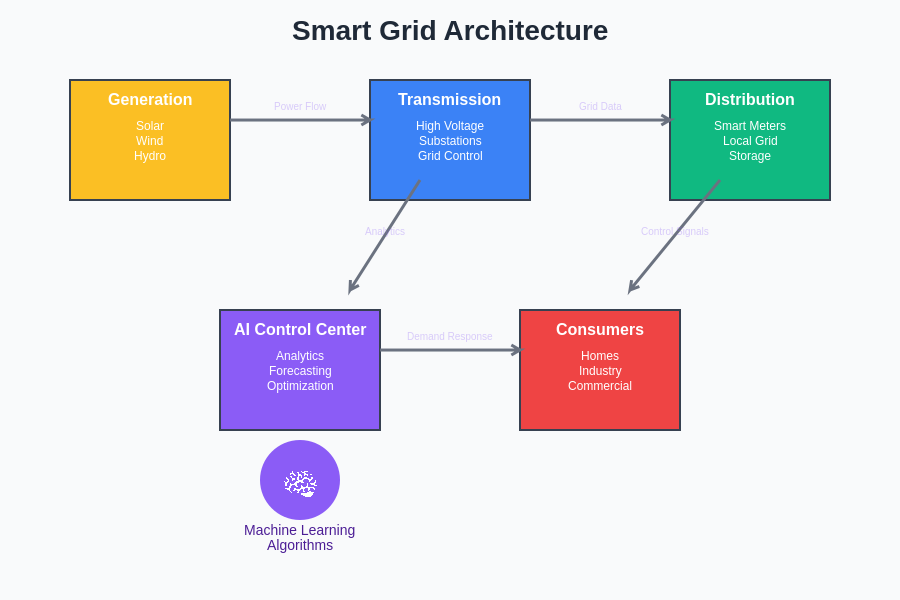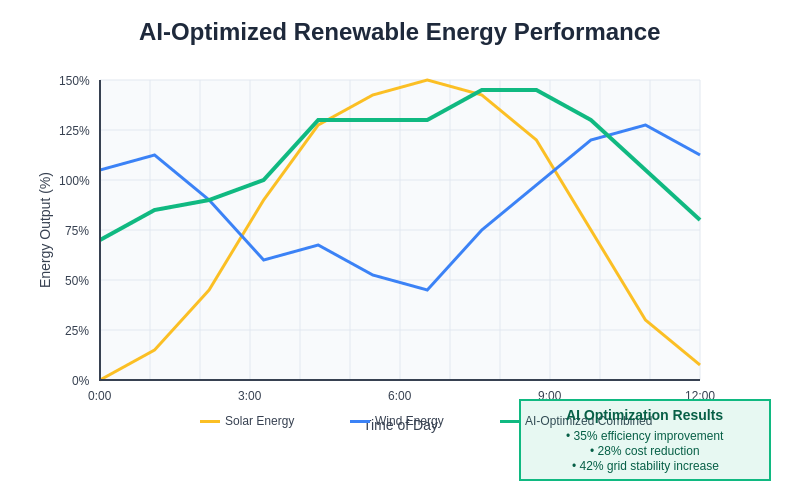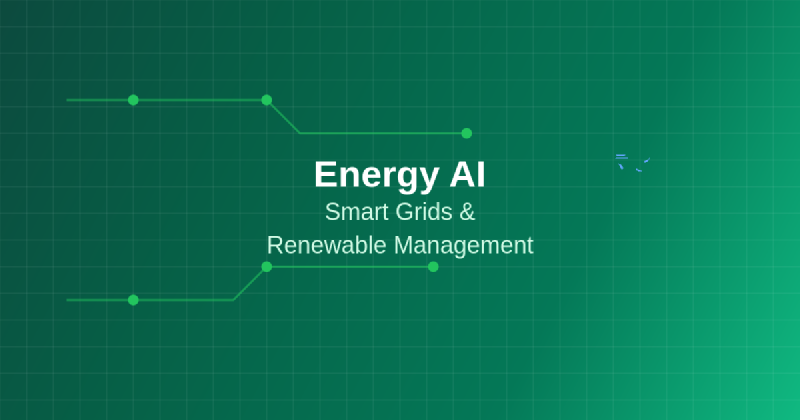The convergence of artificial intelligence and energy infrastructure represents one of the most transformative developments in modern power systems, fundamentally reshaping how we generate, distribute, and consume electricity. Energy AI has emerged as the cornerstone technology enabling the transition from traditional centralized power grids to intelligent, adaptive networks capable of seamlessly integrating renewable energy sources while optimizing efficiency and reliability across entire electrical ecosystems.
Explore the latest AI innovations in energy technology to understand how machine learning algorithms are revolutionizing everything from solar panel efficiency optimization to predictive maintenance of wind turbines. This technological revolution extends far beyond simple automation, creating intelligent energy systems that can predict demand patterns, automatically balance supply and demand, and make real-time decisions that maximize both economic efficiency and environmental sustainability.
The Foundation of Smart Grid Intelligence
Smart grids represent the neural network of modern energy infrastructure, utilizing sophisticated AI algorithms to monitor, analyze, and control electrical distribution systems with unprecedented precision and responsiveness. These intelligent networks fundamentally differ from traditional power grids by incorporating bidirectional communication capabilities, real-time data analytics, and autonomous decision-making systems that can adapt to changing conditions within milliseconds of detection.
The implementation of AI-driven smart grid technology has enabled utility companies to achieve remarkable improvements in energy efficiency, with some systems demonstrating up to thirty percent reductions in energy waste through optimized load balancing and predictive maintenance protocols. These systems continuously analyze massive datasets from sensors, smart meters, weather stations, and consumer usage patterns to create comprehensive models that predict energy demand with extraordinary accuracy, allowing for proactive adjustments that prevent blackouts and minimize energy costs.
The integration of machine learning algorithms into grid management systems has also revolutionized fault detection and response capabilities, enabling automatic identification and isolation of electrical faults before they can cascade into larger system failures. This predictive approach to grid maintenance has significantly reduced downtime while extending the operational lifespan of critical infrastructure components through optimized maintenance scheduling and early intervention protocols.

Modern smart grid architecture demonstrates the sophisticated integration of artificial intelligence across generation, transmission, and distribution systems, creating a unified intelligent network that optimizes energy flow while maintaining grid stability and reliability through continuous monitoring and adaptive control mechanisms.
Revolutionizing Renewable Energy Integration
One of the most significant challenges in renewable energy adoption has been the intermittent nature of sources like solar and wind power, which can fluctuate dramatically based on weather conditions and time of day. Energy AI has addressed this fundamental limitation by developing sophisticated forecasting models that can predict renewable energy generation with remarkable accuracy, enabling grid operators to make informed decisions about energy storage, backup generation, and load distribution strategies.
Discover advanced AI capabilities with Claude for analyzing complex energy data patterns and optimizing renewable resource allocation across diverse geographical regions. These AI systems analyze historical weather data, satellite imagery, atmospheric conditions, and real-time sensor information to generate highly accurate predictions of solar irradiance and wind patterns up to several days in advance, allowing grid operators to optimize energy storage charging cycles and coordinate with conventional power generation facilities.
Machine learning algorithms have also enabled the development of intelligent energy storage systems that can automatically determine optimal charging and discharging schedules based on predicted demand patterns, energy prices, and renewable generation forecasts. These systems have proven particularly effective in maximizing the economic value of stored energy while ensuring grid stability during periods of high renewable generation variability.

The performance improvements achieved through AI-optimized renewable energy systems demonstrate substantial gains in efficiency and reliability, with intelligent coordination of solar and wind resources producing significantly higher combined output than traditional independent operation of these renewable sources.
Optimizing Energy Demand Response
Demand response management represents another critical application of Energy AI, where intelligent systems automatically adjust energy consumption patterns across residential, commercial, and industrial sectors to match available supply and minimize peak demand stress on the electrical grid. These systems utilize sophisticated algorithms to analyze historical consumption patterns, predict future demand, and coordinate with thousands of connected devices to implement optimal load balancing strategies without compromising user comfort or operational requirements.
Smart home and building automation systems powered by AI have demonstrated remarkable capabilities in reducing energy consumption while maintaining optimal environmental conditions for occupants. These systems learn individual usage patterns, preferences, and schedules to automatically adjust heating, cooling, lighting, and appliance operations in ways that minimize energy consumption during peak demand periods while ensuring maximum comfort and convenience for users.
Industrial demand response programs have achieved even more dramatic results, with AI systems coordinating complex manufacturing processes to shift energy-intensive operations to periods of low grid demand or high renewable energy availability. These intelligent scheduling systems have enabled some manufacturing facilities to reduce their energy costs by up to forty percent while actually improving production efficiency through optimized process timing and resource allocation.
Advanced Energy Analytics and Forecasting
The application of artificial intelligence to energy analytics has created unprecedented visibility into power system operations, enabling utilities and energy managers to make data-driven decisions that optimize both economic and environmental performance. Advanced machine learning models analyze vast quantities of operational data to identify patterns, anomalies, and optimization opportunities that would be impossible for human analysts to detect within the massive datasets generated by modern energy infrastructure.
Predictive analytics systems have revolutionized energy planning by providing accurate long-term forecasts of energy demand, renewable resource availability, and infrastructure maintenance requirements. These systems consider numerous variables including economic indicators, demographic trends, weather patterns, and technological adoption rates to generate comprehensive energy planning scenarios that guide investment decisions and policy development for decades into the future.
Real-time energy analytics platforms powered by AI provide grid operators with instantaneous insights into system performance, enabling rapid response to changing conditions and proactive management of potential issues before they impact system reliability. These platforms integrate data from thousands of sensors, smart meters, and monitoring devices to create comprehensive situational awareness that supports optimal decision-making across all aspects of grid operations.
Enhancing Energy Storage Optimization
Energy storage systems represent a critical component of modern renewable energy infrastructure, and AI has fundamentally transformed how these systems are managed and optimized for maximum efficiency and longevity. Intelligent battery management systems utilize machine learning algorithms to analyze usage patterns, degradation characteristics, and performance metrics to optimize charging and discharging cycles in ways that maximize both energy capacity utilization and battery lifespan.
Enhance your research capabilities with Perplexity to explore cutting-edge developments in battery technology and energy storage optimization algorithms that are driving improvements in renewable energy reliability and cost-effectiveness. These AI-driven systems have enabled significant improvements in battery performance, with some installations demonstrating up to twenty-five percent improvements in useful capacity through optimized charging protocols and thermal management strategies.
Large-scale energy storage installations benefit from AI systems that coordinate multiple battery arrays, optimize power conversion efficiency, and manage complex interactions with grid operators and renewable energy sources. These systems continuously analyze market conditions, grid demand patterns, and renewable generation forecasts to determine optimal energy trading strategies that maximize economic returns while supporting grid stability and reliability requirements.
Predictive Maintenance and Asset Management
The implementation of AI-powered predictive maintenance systems has revolutionized how energy infrastructure assets are managed and maintained, shifting from reactive repair strategies to proactive maintenance programs that prevent failures before they occur. Machine learning algorithms analyze vibration patterns, thermal signatures, electrical characteristics, and operational data from critical infrastructure components to identify early indicators of potential failures, enabling maintenance teams to address issues during planned downtime rather than emergency repair situations.
Wind turbine maintenance has particularly benefited from AI-driven predictive analytics, with intelligent monitoring systems capable of detecting bearing wear, gearbox problems, and blade damage weeks or months before these issues would cause turbine failures. These early warning systems have dramatically reduced maintenance costs while improving turbine availability and extending operational lifespans through optimized maintenance scheduling and component replacement strategies.
Solar panel performance monitoring systems powered by AI can identify individual panel failures, optimize cleaning schedules, and detect installation issues that impact overall system efficiency. These systems analyze electrical output characteristics, thermal patterns, and environmental conditions to maximize energy generation while minimizing maintenance requirements and operational costs across large-scale solar installations.
Grid Resilience and Security Enhancement
Modern power grids face unprecedented challenges from both natural disasters and cybersecurity threats, and AI has emerged as a critical technology for enhancing grid resilience and security across multiple dimensions. Intelligent grid management systems can automatically reconfigure electrical networks to maintain power delivery during equipment failures, natural disasters, or cyber attacks, utilizing real-time analysis of grid conditions to identify alternative power flow paths and optimize system performance under degraded conditions.
Cybersecurity applications of Energy AI include sophisticated anomaly detection systems that continuously monitor grid communications and control systems for signs of unauthorized access or malicious activity. These systems utilize machine learning algorithms trained on normal grid operations to identify subtle deviations that may indicate cyber attacks, enabling rapid response and system isolation to prevent widespread damage or service disruption.
Natural disaster response capabilities have been significantly enhanced through AI systems that integrate weather forecasting, grid modeling, and emergency response protocols to prepare power systems for extreme weather events. These systems can automatically implement protective measures, coordinate with emergency services, and optimize resource allocation to minimize service disruptions and accelerate recovery operations following major weather events.
Economic Optimization and Market Integration
Energy markets have become increasingly complex with the integration of renewable energy sources, distributed generation, and flexible demand response programs, creating opportunities for AI systems to optimize economic performance across multiple market segments and time scales. Intelligent energy trading systems analyze market conditions, grid constraints, and generation capabilities to execute optimal trading strategies that maximize revenue while ensuring grid stability and regulatory compliance.
Real-time pricing optimization represents another significant application of Energy AI, where dynamic pricing algorithms adjust electricity rates based on supply and demand conditions, grid constraints, and consumer behavior patterns. These systems have demonstrated the ability to reduce peak demand by encouraging energy consumption during periods of low grid stress while providing economic incentives for consumers to participate in demand response programs.
Investment optimization for renewable energy projects has been revolutionized through AI systems that analyze meteorological data, grid interconnection requirements, economic conditions, and regulatory frameworks to identify optimal locations and configurations for new renewable energy installations. These systems consider numerous variables including land costs, transmission requirements, environmental impacts, and long-term market conditions to guide investment decisions that maximize both financial returns and environmental benefits.
Environmental Impact Assessment and Optimization
The environmental applications of Energy AI extend beyond simple renewable energy integration to encompass comprehensive environmental impact assessment and optimization across entire energy systems. Machine learning algorithms analyze emissions data, environmental monitoring information, and operational parameters to identify opportunities for reducing the carbon footprint of energy generation and distribution while maintaining reliable service delivery.
Carbon footprint optimization systems powered by AI can automatically adjust generation dispatch orders to minimize greenhouse gas emissions while meeting grid demand requirements and economic constraints. These systems consider the carbon intensity of different generation sources, transmission losses, and demand patterns to create optimal generation schedules that reduce overall system emissions without compromising grid reliability or economic performance.
Environmental monitoring applications utilize AI to analyze air quality data, water usage patterns, and ecosystem impacts associated with energy infrastructure operations. These systems provide real-time feedback on environmental performance while identifying opportunities for improvement through operational modifications, technology upgrades, or infrastructure investments that reduce environmental impact while maintaining or improving energy system performance.
Future Innovations and Emerging Technologies
The future of Energy AI promises even more sophisticated applications as emerging technologies like quantum computing, advanced sensor networks, and next-generation communication systems enable new capabilities in energy system optimization and management. Quantum-enhanced optimization algorithms may eventually solve complex energy scheduling problems that are currently computationally intractable, enabling more efficient utilization of renewable resources and grid infrastructure.
Artificial intelligence integration with emerging energy technologies such as hydrogen production, advanced nuclear systems, and space-based solar power will create new opportunities for optimizing these systems and integrating them effectively with existing energy infrastructure. These advanced applications will require continued development of AI algorithms specifically designed for complex energy system interactions and multi-objective optimization across economic, environmental, and reliability constraints.
The continued evolution of Energy AI will likely focus on developing more autonomous and adaptive systems capable of managing increasingly complex energy networks with minimal human intervention while maintaining the flexibility to respond to unprecedented situations and changing requirements. These systems will need to balance multiple objectives including cost minimization, environmental impact reduction, reliability maximization, and security enhancement while adapting to technological changes and evolving regulatory requirements.
The transformation of global energy infrastructure through artificial intelligence represents one of the most significant technological advances of our time, with implications that extend far beyond the energy sector to encompass economic development, environmental sustainability, and quality of life for billions of people worldwide. As these technologies continue to mature and evolve, they will play an increasingly critical role in addressing climate change, energy security, and sustainable development challenges that define the twenty-first century.
Disclaimer
This article is for informational purposes only and does not constitute professional advice regarding energy systems, investment decisions, or technology implementation. The information presented reflects current understanding of Energy AI applications and may not account for all technical, economic, or regulatory considerations relevant to specific situations. Readers should consult with qualified professionals and conduct thorough research before making decisions related to energy technology investments or implementations.
